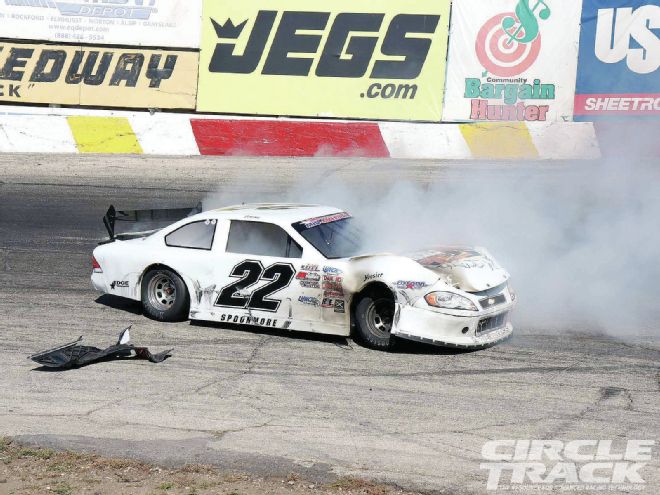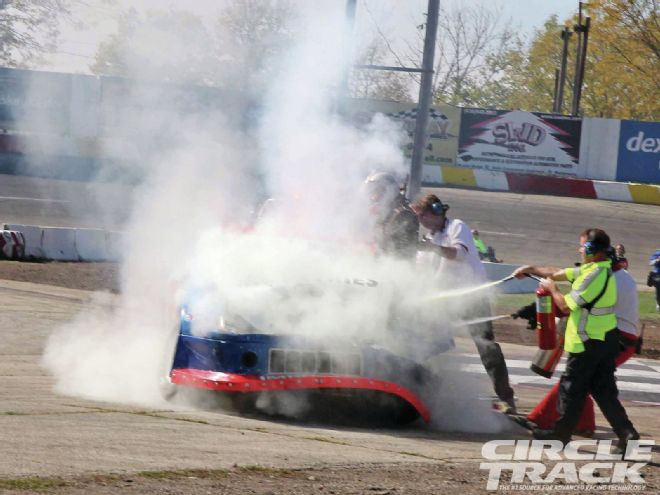
It happens in an instant. One second you're holding your line, fighting for position. The next, and often times without warning, a mechanical failure or a wreck of almost any degree turns from bad to worse as fire erupts, turning your race car into a flaming ball of metal. Are you and your race car prepared for such a catastrophe? No one is immune from the possibility of fire, and it's something every racer, and their cars should be prepared for before it happens.
The No. 22 car of Jeremy Spoonmore (pictured above) erupted into flames after a catastrophic engine failure ignited two gallons of oil from the wet-sump lubrication system. The cockpit was completely engulfed in flames, causing damage to the window net, seat, Spoonmore's firesuit, gloves, shoes, helmet, and seatbelts. We were also told his impressive goatee was significantly shorter after the fire. Spoonmore recalls the events of that day.
"There was more fire than I would have ever thought there would have been," explains Spoonmore. "The engine seized and I heard a pop. When it did, a rod came out of the block and the oil ignited on the headers. When I turned the wheel down I saw the flames. The fire started coming into the cockpit and got very close to my face so I closed my eyes so it didn't burn them."
At this point, Spoonmore should have been able to come to a stop and get out of the car, but bad turned worse. Another car slid in the oil left on the track, knocking Jeremy into the wall. "The power steering broke when the car hit the wall, igniting more fluid," Spoonmore adds. "And that just made the fire worse. I already had the window net down and was about to undo my belts. Luckily they were still on."
In the end, Spoonmore walked away with burns about as severe as a bad sunburn and a shortened goatee, but some racers aren't that lucky. "I never even thought about fire in the race car," explains Spoonmore. "I hope it will never happen again, but I learned the hard way."
Surviving a fire in a race car is a game of time. If a fire erupts, you want to give yourself enough time to safely stop the car and get out. If the fire happens as a result of a wreck and you are unconscious, you want to be protected for enough time that the safety crew can get there and remove you from the car. Racers never want to be reminded of the dangers of racing, but not preparing for the worst is silly when you think how easy it is to be prepared.
Emerging from a fire like Spoonmore's unscathed is as much about preparation as it is about luck. Racing is inherently dangerous, and taking the proper precautions greatly diminished the risk of injury, and it starts with what you wear.
We all know wearing the proper firesuit, fire retardant underwear, head sock, gloves, and shoes can be uncomfortable, especially in the heat of the summer, but the healing process from third degree burns is far worse.
Firesuits come with an SFI rating. This rating gives you an idea of how protective it will be in a fire. Your firesuit is designed to protect you, but you have to take care of your firesuit properly for it to do its job when needed. So many times you see racers jump out of the car, dive under the car, and start turning wrenches. While the ability to drive and wrench on a race car is admirable, it can be foolish if you don't remove your firesuit. Dirt, solvents, fuels, and oils can turn a piece of fire retardant clothing into an oily flammable rag—probably the last thing you want to be wearing if there ever was a fire.
The moral of the story is don't ever work on the car in your firesuit. While it's easier than changing, and takes less time, the extra five minutes could save your life the next time you go on track. The same also goes for shoes and gloves.
Most racers don't realize that cleaning your firesuit the wrong way could reduce its fire resistant characteristics. We went to G-Force Racing Gear for a little more info on cleaning your safety gear.
When in doubt, mild soap and water will work with most any product. As for racing suits, wash in cold water and hang to dry. Some manufacturers recommend dry cleaning, but to be sure of the chemicals used, you should wash at home. With helmets, a damp cloth and mild soap used to blot the inside of the liner will help remove any built up residue. Belts are susceptible to sunlight and water will speed up the aging process. Be sure to remove or cover belts when washing the inside of a racing vehicle.
Beyond protective clothing, preparing the car for the worst is hugely important. The driver's compartment should be as sealed as possibly with tape that won't burn. There are aluminum tapes that are specifically designed for sealing areas of the car that could possibly be exposed to fire and high heat. Even the smallest holes can let fluids and fire into the cockpit.
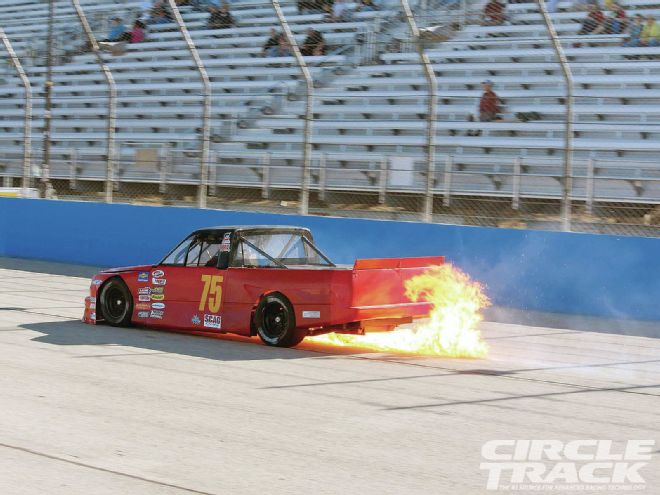
Once the driver's compartment is sealed, a fire extinguisher or fire system should be in place, in working order, and the activation mechanism should be in an easy place for the driver to operate if needed. Also, the system does no good if the safety pin is still in place. Be sure to remove it before each trip out on track.
Lastly, have an exit strategy and practice it. Having all of the safety equipment means nothing if you can't get out of your car. Especially with how popular full-containments seats and head-and-neck restraints have become, getting out of a race car, let alone a burning one, can be very difficult with obstacles on you and in the way.
A fire can induce panic; hey, it's a natural reaction if you're on fire. But practicing getting out on a regular basis can make a scary moment a little less frightening if you know exactly how to do it. Have a crewmember time your evacuation from the car. Practice a few times and break out the stopwatch again. We bet you'll be surprised at how much you can improve in just a few tries.
If you've ever worn any kind of protecting equipment, chances are you've seen the SFI tags on them. Besides the fact that in-date SFI-rated equipment is required, it also allows you to pick the right equipment for what you are doing.
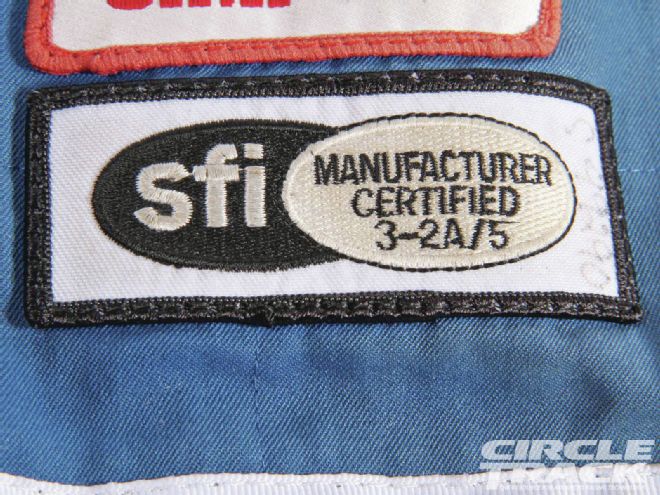 The SFI tags on fires suits are there for more than just letting your tech offiicials know if your stuff is in date. The numbers tell you the level of protection your suit offers.
The SFI tags on fires suits are there for more than just letting your tech offiicials know if your stuff is in date. The numbers tell you the level of protection your suit offers.
Safety manufacturers who advertise in Circle Track produce products that carry SFI ratings. A typical rating looks like this: SFI 3.2A/5 where 3.2A is the foundation's standard for firesuits and 5 is the rating. The higher that rating number, the better the protection. In this example, the number 5 is the most important number you will see, especially if the manufacturer doesn't release TPP numbers. Most sanctioning bodies and tracks will require you to have a firesuit with a minimum SFI-rating in order to compete. However, that does not mean that you should buy only their minimum.
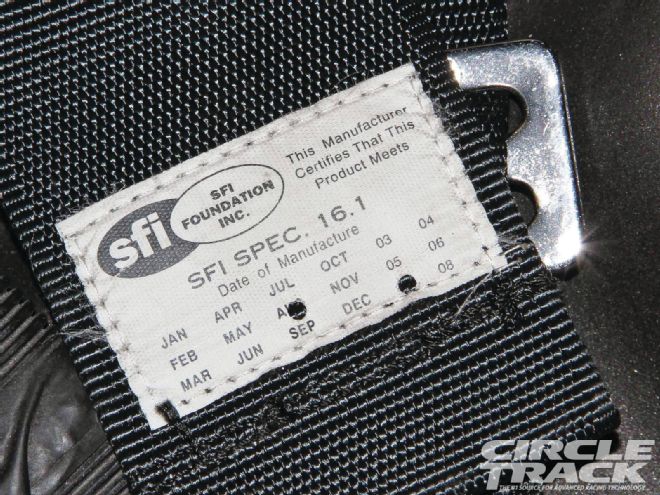 The date tags also let you now when it’s time to replace old safety equipment. Keeping your safety equipment in date is in your best interest, as a fire could erupt at any time on track.
The date tags also let you now when it’s time to replace old safety equipment. Keeping your safety equipment in date is in your best interest, as a fire could erupt at any time on track.
The quality of any fire-retardant material can be determined by looking closely at two measuring factors: LOI, which stands for Limiting Oxygen Index, and TPP or Thermal Protective Performance. LOI is the most commonly used measurement for flame retardancy and refers to the amount of oxygen needed in the atmosphere to support combustion. If a fiber or fabric has an LOI of 25, that means that at least 25 percent oxygen needs to be present for the fabric to burn. Consequently, a higher rating equals more fire protection. You won't often see LOI in race suit literature, but it's an important factor in good fire protection.
TPP on the other hand refers to the garment's ability to provide thermal protection when exposed to both direct flame and radiant heat while taking into account the length of time before a person is subject to second-degree burns. While that's a mouthful, TPP is the second most important number you need to know when firesuit shopping. The TPP rating is derived from a mathematical calculation performed with the results of a sophisticated test procedure that utilizes two different heat sources, sensors, and the fabric to be tested. The TPP rating is divided in half to determine the number of seconds until the human tissue reaches a second-degree burn. For example, if a particular fabric has a TPP rating of 35, it takes 17.5 seconds until a second-degree burn occurs in a flashover situation.
The only way to increase a TPP rating is through adding multiple layers. However, as you increase layers, suits get bulkier—and bulk doesn't equal comfort. Your goal in selecting a firesuit should be the balance of comfort with maximum protection.
A great way to increase the TPP without jumping up to a three-layer drag racing suit is to wear fire-retardant underwear beneath your suit. If you're budget doesn't allow for FR underwear, even a cotton sweatshirt adds some protection.
OK, now here's a great question to ask yourself. How fast can the safety crew at your local track get you out of a burning car? If they can do it in 3 seconds, go ahead and buy that $99 single-layer special and drop me a note telling me your home track because I want to race there.
